Gamification in Education

Educators can benefit from gamified environments by using the concept of measurable goals. These goals can be completed tasks, skills demonstrated, or even the performance of students during a game. The goal should be challenging but attainable. Gamification creates a safe environment where students can experience failure and succeed again when things do not go as planned. Gamified learning environments also provide clues and reward structures to motivate students to keep trying.
There are three basic styles of gamification. The first method is based on using various digital and non-digital resources. Gamification is a process in which students make learning more fun by integrating game elements. The second approach involves implementing a gamification platform or game-oriented teaching tools. On the other hand, rigid gamification involves ready-built game-oriented teaching tools. This approach is the least customizable, but may be sufficient for certain purposes. Visit for know about : my puppy poop
Another method of pacifying educational material is to replace grades with experience points. Gamification in education involves repackaging grades into experience points, with the idea of rewarding students for completing objectives. The term leveling up has been used to describe grade improvement, with Master Level being the equivalent of an A in school records. It also helps students develop their problem-solving skills and build confidence by making learning fun and engaging. This method is largely effective for creating engagement and motivation among students.
